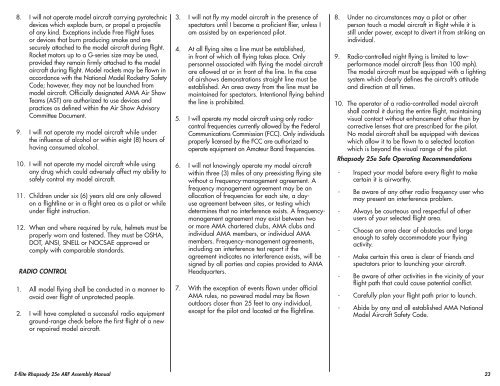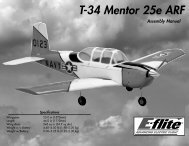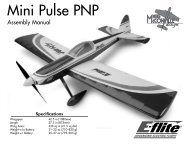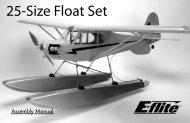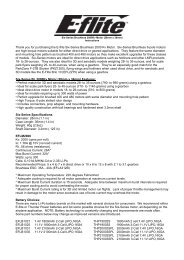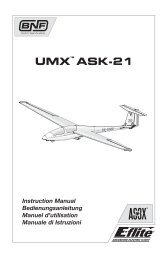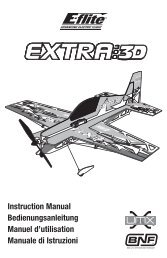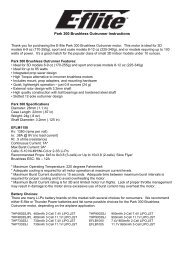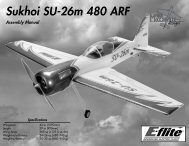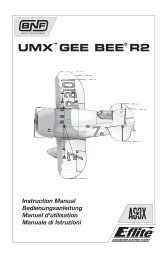You also want an ePaper? Increase the reach of your titles
YUMPU automatically turns print PDFs into web optimized ePapers that Google loves.
8. I will not operate model aircraft carrying pyrotechnic<br />
devices which explode burn, or propel a projectile<br />
of any kind. Exceptions include Free Flight fuses<br />
or devices that burn producing smoke and are<br />
securely attached to the model aircraft during flight.<br />
Rocket motors up to a G-series size may be used,<br />
provided they remain firmly attached to the model<br />
aircraft during flight. Model rockets may be flown in<br />
accordance with the National Model Rocketry Safety<br />
Code; however, they may not be launched from<br />
model aircraft. Officially designated AMA Air Show<br />
Teams (AST) are authorized to use devices and<br />
practices as defined within the Air Show Advisory<br />
Committee Document.<br />
9. I will not operate my model aircraft while under<br />
the influence of alcohol or within eight (8) hours of<br />
having consumed alcohol.<br />
10. I will not operate my model aircraft while using<br />
any drug which could adversely affect my ability to<br />
safely control my model aircraft.<br />
11. Children under six (6) years old are only allowed<br />
on a flightline or in a flight area as a pilot or while<br />
under flight instruction.<br />
12. When and where required by rule, helmets must be<br />
properly worn and fastened. They must be OSHA,<br />
DOT, ANSI, SNELL or NOCSAE approved or<br />
comply with comparable standards.<br />
RADIO CONTROL<br />
1. All model flying shall be conducted in a manner to<br />
avoid over flight of unprotected people.<br />
2. I will have completed a successful radio equipment<br />
ground-range check before the first flight of a new<br />
or repaired model aircraft.<br />
3. I will not fly my model aircraft in the presence of<br />
spectators until I become a proficient flier, unless I<br />
am assisted by an experienced pilot.<br />
4. At all flying sites a line must be established,<br />
in front of which all flying takes place. Only<br />
personnel associated with flying the model aircraft<br />
are allowed at or in front of the line. In the case<br />
of airshows demonstrations straight line must be<br />
established. An area away from the line must be<br />
maintained for spectators. Intentional flying behind<br />
the line is prohibited.<br />
5. I will operate my model aircraft using only radiocontrol<br />
frequencies currently allowed by the Federal<br />
Communications Commission (FCC). Only individuals<br />
properly licensed by the FCC are authorized to<br />
operate equipment on Amateur Band frequencies.<br />
6. I will not knowingly operate my model aircraft<br />
within three (3) miles of any preexisting flying site<br />
without a frequency-management agreement. A<br />
frequency management agreement may be an<br />
allocation of frequencies for each site, a dayuse<br />
agreement between sites, or testing which<br />
determines that no interference exists. A frequencymanagement<br />
agreement may exist between two<br />
or more AMA chartered clubs, AMA clubs and<br />
individual AMA members, or individual AMA<br />
members. Frequency-management agreements,<br />
including an interference test report if the<br />
agreement indicates no interference exists, will be<br />
signed by all parties and copies provided to AMA<br />
Headquarters.<br />
7. With the exception of events flown under official<br />
AMA rules, no powered model may be flown<br />
outdoors closer than 25 feet to any individual,<br />
except for the pilot and located at the flightline.<br />
8. Under no circumstances may a pilot or other<br />
person touch a model aircraft in flight while it is<br />
still under power, except to divert it from striking an<br />
individual.<br />
9. Radio-controlled night flying is limited to lowperformance<br />
model aircraft (less than 100 mph).<br />
The model aircraft must be equipped with a lighting<br />
system which clearly defines the aircraft’s attitude<br />
and direction at all times.<br />
10. The operator of a radio-controlled model aircraft<br />
shall control it during the entire flight, maintaining<br />
visual contact without enhancement other than by<br />
corrective lenses that are prescribed for the pilot.<br />
No model aircraft shall be equipped with devices<br />
which allow it to be flown to a selected location<br />
which is beyond the visual range of the pilot.<br />
<strong>Rhapsody</strong> <strong>25e</strong> Safe Operating Recommendations<br />
- Inspect your model before every flight to make<br />
certain it is airworthy.<br />
- Be aware of any other radio frequency user who<br />
may present an interference problem.<br />
- Always be courteous and respectful of other<br />
users of your selected flight area.<br />
- Choose an area clear of obstacles and large<br />
enough to safely accommodate your flying<br />
activity.<br />
- Make certain this area is clear of friends and<br />
spectators prior to launching your aircraft.<br />
- Be aware of other activities in the vicinity of your<br />
flight path that could cause potential conflict.<br />
- Carefully plan your flight path prior to launch.<br />
- Abide by any and all established AMA National<br />
Model Aircraft Safety Code.<br />
E-<strong>flite</strong> <strong>Rhapsody</strong> <strong>25e</strong> <strong>ARF</strong> Assembly Manual<br />
23


